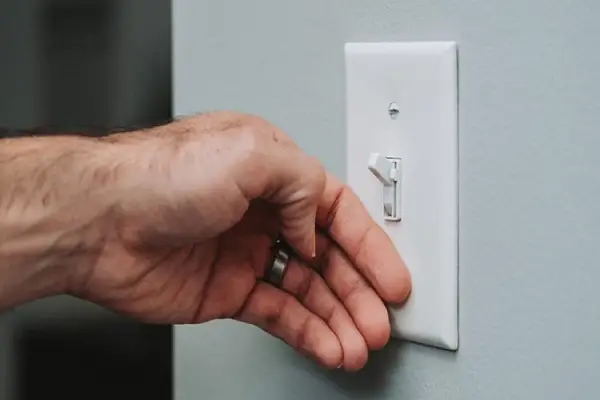
Mr. Electric explains that a dimmer switch feeling warm is usually normal, but excessive heat may signal issues
|
While it’s normal for a dimmer switch to warm up when in operation, at no point should it feel like it’s overheating. Electrical components are designed to operate within safe temperature ranges. If your dimmer switch is hot to the touch, it may be overloaded, posing a fire risk. In this article, we’ll explain what causes a warm light switch, how to determine normal vs. dangerous temperatures, and when it’s time to call in an electrician.
Common Causes of a Warm Dimmer Switch
Here are the most likely culprits behind that unexpected heat:
Dimmer switch functionality
Dimmer switches work by absorbing some of the electrical energy they regulate, which can make them warm during use. A dimmer switch that’s warm to the touch is normal.
Overloaded circuit
If a switch controls a high number of fixtures or lights, the load may exceed safe electrical limits. This can cause overheating—especially in older homes not built for today’s lighting demands.
Faulty wiring
Loose wires, poor connections, or degraded insulation can create electrical resistance, which generates heat. A hot light switch could mean trouble is hiding behind the wall.
Aging or damaged switch
Like any component, dimmer switches wear out with use. If your switch is decades old, it's more likely to have degraded connections, increased resistance, or internal shorts.
Signs That Your Dimmer Switch Is Too Hot
Not sure whether your dimmer switch is too hot or just right? Here are a few indicators to look for:
Your dimmer exceeds the recommended temperature
All dimmer switches generate heat, which is dissipated through the front of the dimmer and partially transferred through the wall plate, resulting in warmth.
According to Underwriters Laboratories (UL 1472), a global electrical safety organization, dimmer switches are safe when operating at or below 195 degrees Fahrenheit. The average dimmer typically operates at around 140 degrees Fahrenheit. If your dimmer is hot or scalding to the touch, the temperature is likely exceeding this limit.
An infrared thermometer will provide an accurate reading. If you don’t have one, err on the side of safety and contact a qualified electrician to assess the situation. In the meantime, leave the switch off.
The dimmer switch is overloaded
Dimmer switches can typically handle up to 1500 watts of electricity at a time—plenty of power for most household lighting needs. However, if you have sixteen 100W light bulbs all controlled by one dimmer, the 1600W total will overload the switch, resulting in excessive heat buildup.
If you suspect your dimmer switch is too hot, check the ratings of every light source it controls. Removing a bulb or two may provide the solution.
What to Do If Your Dimmer Switch Is Hot to the Touch
If your dimmer switch exceeds safe temperature thresholds or is too hot for comfort, follow these steps:
- Stop using the switch. Avoid activating the dimmer until it’s been assessed. If the heat is severe or smells like burning, turn off the power at your breaker panel.
- Unplug connected loads. If the switch controls outlets or plug-in lighting, unplug those devices. This helps relieve the load and rules out external factors.
- Schedule a professional inspection. Even if the switch cools down, the root problem may still exist. A qualified electrician can safely open the wall and inspect the wiring, connections, and circuit load.
A hot dimmer switch can pose a fire risk. The heat can cause the thermoplastic coating that covers the wires to crack and lose its insulating ability, leading to dangerous short circuits and arc faults. Learn more about professional dimmer switch repair services by certified electricians near you.
Preventing Hot Switches: Pro Tips for Homeowners
Keep your dimmer switches cool (and your home safer) with these tips:
- Only use switches rated for the proper load.
- Don’t overload circuits with multiple high-wattage fixtures.
- Upgrade old switches with modern, energy-efficient dimmers.
- Avoid mixing LED bulbs with incompatible dimmers.
- Have your electrical system inspected every 5–10 years.
If your home came with outdated dimmers, it’s probably time for an upgrade. Learn more about installing dimmer switches and enjoy a safer, more efficient lighting system.
Contact Mr. Electric for Dimmer Switch Service
Your wall plate shouldn't double as a hand warmer. Excessive heat coming from a dimmer switch is a warning sign you shouldn’t ignore. With professional inspection, updated components, and routine electrical maintenance, you can flip the switch on danger—and light the way to safety.
Need help diagnosing a warm switch? The qualified electricians on your local Mr. Electric® team provide expert service, including lighting installation, repair, and assessment, all backed by the Neighborly Done Right Promise® to ensure your satisfaction. Request an appointment today!
This article is intended for general guidance only and is not applicable to every situation. You are responsible for determining the proper course of action for your property and situation. Mr. Electric is not responsible for any damages that occur as a result of advice and/or guidance derived from its blog content.
FAQs About Warm Dimmer Switches
The safety of you, your family, and your home are the top priority of every Mr. Electric service professional. Our safety-first commitment to solving your electrical issues includes a meticulous attention to detail on every job. Our commitment also includes using our years of experience to answer your questions. Below are answers to some of the most frequently asked questions about why a dimmer switch is warm to the touch.
Why is my light switch hot to the touch?
A light switch that’s too hot to touch may be overloaded, aging, or wired incorrectly. If it’s a dimmer, slight warmth is normal, but excessive heat (over 195℉) usually signals a serious issue.
What to do with a hot light switch:
- Stop using the switch
- Turn off the breaker if it’s very hot
- Contact a qualified electrician for inspection
Is it normal for a dimmer switch to be warm?
Yes, a warm light switch on a dimmer is generally safe. Dimmer switches work by dissipating excess energy as heat. However, it should never be hot, make noises, or smell burnt.
Can a light switch cause a fire?
Yes. Excessive heat from faulty switches, wiring, or overloading can ignite surrounding materials and cause electrical fires.
Prevention tips:
- Avoid using switches past their rated capacity
- Replace any that are warm, cracked, or old
- Schedule regular electrical system evaluations
What should I do if my dimmer switch is hot but the lights are off?
This isn’t normal. If your dimmer switch is hot while the lights are off, it could indicate a faulty switch, wiring issue, or internal failure. Turn off the power from the breaker panel and contact an electrician.
When should you replace a dimmer switch?
Even high-quality dimmer switches can fail over time. You should consider replacing yours if:
- It gets hot even when the lights are off.
- Lights flicker or pulse.
- You’ve upgraded to LED bulbs, but the dimmer is rated for incandescent.
- It’s over 10 years old.
Modern dimmers are safer, cooler, and more compatible with today's lighting systems.
How do I figure out the maximum load for a dimmer switch?
First, check the lighting fixture for a sticker displaying its wattage rating. If the dimmer controls multiple light fixtures, add the total wattage of all fixtures together.
Turn the power off, then compare the total to the dimmer switch’s wattage rating (usually stamped into the mounting bracket). If the total fixture wattage exceeds the dimmer’s wattage rating, this is the likely reason why your dimmer switch gets hot.
